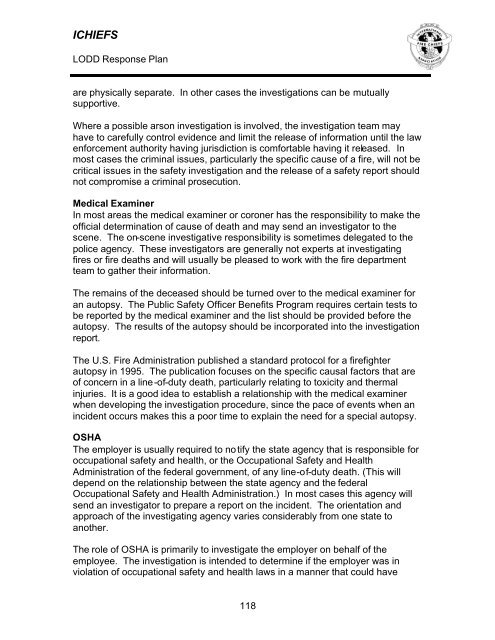Five Principles of Notification - IAFF
Five Principles of Notification - IAFF
Five Principles of Notification - IAFF
Create successful ePaper yourself
Turn your PDF publications into a flip-book with our unique Google optimized e-Paper software.
ICHIEFS<br />
LODD Response Plan<br />
are physically separate. In other cases the investigations can be mutually<br />
supportive.<br />
Where a possible arson investigation is involved, the investigation team may<br />
have to carefully control evidence and limit the release <strong>of</strong> information until the law<br />
enforcement authority having jurisdiction is comfortable having it released. In<br />
most cases the criminal issues, particularly the specific cause <strong>of</strong> a fire, will not be<br />
critical issues in the safety investigation and the release <strong>of</strong> a safety report should<br />
not compromise a criminal prosecution.<br />
Medical Examiner<br />
In most areas the medical examiner or coroner has the responsibility to make the<br />
<strong>of</strong>ficial determination <strong>of</strong> cause <strong>of</strong> death and may send an investigator to the<br />
scene. The on-scene investigative responsibility is sometimes delegated to the<br />
police agency. These investigators are generally not experts at investigating<br />
fires or fire deaths and will usually be pleased to work with the fire department<br />
team to gather their information.<br />
The remains <strong>of</strong> the deceased should be turned over to the medical examiner for<br />
an autopsy. The Public Safety Officer Benefits Program requires certain tests to<br />
be reported by the medical examiner and the list should be provided before the<br />
autopsy. The results <strong>of</strong> the autopsy should be incorporated into the investigation<br />
report.<br />
The U.S. Fire Administration published a standard protocol for a firefighter<br />
autopsy in 1995. The publication focuses on the specific causal factors that are<br />
<strong>of</strong> concern in a line-<strong>of</strong>-duty death, particularly relating to toxicity and thermal<br />
injuries. It is a good idea to establish a relationship with the medical examiner<br />
when developing the investigation procedure, since the pace <strong>of</strong> events when an<br />
incident occurs makes this a poor time to explain the need for a special autopsy.<br />
OSHA<br />
The employer is usually required to notify the state agency that is responsible for<br />
occupational safety and health, or the Occupational Safety and Health<br />
Administration <strong>of</strong> the federal government, <strong>of</strong> any line-<strong>of</strong>-duty death. (This will<br />
depend on the relationship between the state agency and the federal<br />
Occupational Safety and Health Administration.) In most cases this agency will<br />
send an investigator to prepare a report on the incident. The orientation and<br />
approach <strong>of</strong> the investigating agency varies considerably from one state to<br />
another.<br />
The role <strong>of</strong> OSHA is primarily to investigate the employer on behalf <strong>of</strong> the<br />
employee. The investigation is intended to determine if the employer was in<br />
violation <strong>of</strong> occupational safety and health laws in a manner that could have<br />
118
















